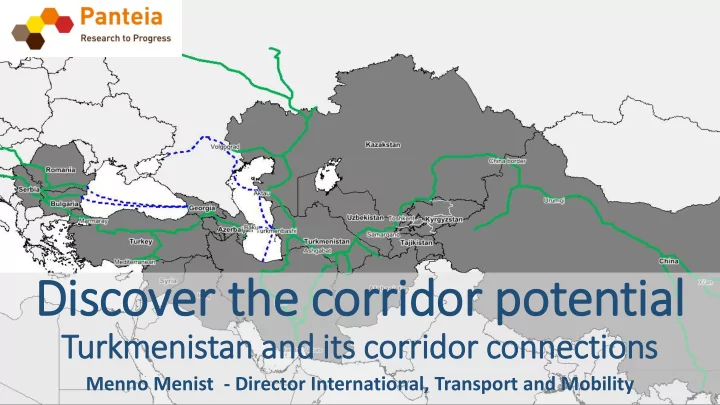

Dis iscover the corrid idor potential Turkmenistan and it its corridor connections Menno Menist - Director International, Transport and Mobility
Co Contents • Trans-European Transport Network (TEN-T) corridor development • Lessons learned from TEN-T • Current and future freight flows • Turkmenistan in a corridor perspective • Making the corridor attractive • Conclusion: discover the corridor potential
Unit ited Natio ions Hig igh Level l Advis isory Group on Sustain inable Transport Recommendations for governments, businesses, and civil society Some important action points: • Base transport planning and investment on prospects for economic growth, social development and environmental impact • Integrate transport over modes, territories and sectors • Create supportive institutional and regulatory frameworks • Promote sustainable transport technologies Overlapping goals with EU’s Trans-European Transport Network (TEN-T) policy.
European Unio ion Trans-European Transport Network (TEN-T) corrid idors Functioning of the internal market and climate change mitigation Key words: • Multimodality • Cross-border • Interoperability • Decarbonization • Resilience
TEN-T corridor studie ies Panteia is involved in 7 out of 9 EU corridor studies
Lessons le learned from TEN-T T Corrid idor approach Creating the conditions for economic growth • Corridor approach as an infrastructure and economic concept • Connecting Networks • Investing in infrastructure augments economic growth and job creation • Hinterland connections to ports • International cooperation • Last mile approach (smooth and efficient pre- and end haulage and transhipment) • Infrastructure should be used in an optimal way • Sufficient capacity and sufficient demand
Turkm kmenis istan in in a corrid idor perspective Growth potential and infrastructure should reinforce each other Key to Turkmenistan’s Development Strategy • Trans-Caspian Corridor in the Silk Road Economic Belt/One Belt One Road (OBOR) strategy • Natural Gas Corridors • Turkmenistan invests heavily in infrastructure Linking up to current developments: • Kars (Turkey)-Tiflis (Georgia)-Baku (Azerbaijan) Railway Project • Marmaray Tunnel under Bosphorus • North-South Corridor • Rail connections with Iran, Afghanistan • Viking Train project (directly connecting the Black and Baltic Seas) • Volga-Don River • New motorways and bridges • New Ashgabat Airport Future project: • Kyrgystan-China connection
Exis xisting – traffic flo low Turkmenistan in middle of biggest tradeflows in the world Turkmenistan Corridor connects important networks Source data: Panteia
2030 - Scenario – International volu lumes 12 Future growth scenario: Turkmenistan international volumes in million ton in 2030 • Turkmenistan import 10 volumes grow. Largest growth in high value & 8 containerized goods • Turkmenistan export 6 volumes grow. 2012 2030 • Petrochemical promising 4 prospects • Trade balance is favorable 2 for Turkmenistan 0 Import import Export export Source data: Panteia containerized containerized
2030 - Scenario – Transit volu lumes Transit Volume in million ton World economic developments 800 generate more transit traffic: • 220 million ton growth in total 700 transit traffic 600 • Annual growth 3.3%, above global average, especially containerized Afgan import 500 goods, oil & gas, chemicals and EU->Caspian Caucasus->Asia building materials EU->Asia 400 Afgan export Caspian->EU 300 Asia->Caucasus Asia->EU 200 100 - Source data: Panteia 2015 2030
Makin ing the corrid idor attractiv ive Hinterland connections Competitive transport Added value for the Turkmenistan economy Sustainability
Hin interla land connections corridor cooperation makes even more attractive corridor Coordinating infastructure works in all corridor countries favors the corridor. • Heavy investment in Turkmenistan rail infrastructure • Developing intermodal terminals • Missing links (including last-mile connections) • Harmonizing border crossing procedures
Competitive tr transport Optimal use and quality transport services Price Transit time Reliability • Complexity of tax systems (state borders) • Information exchange between the parties Turkmenbasy International Sea Port Project • Regulatory issues with regard to multimodal transport • Smooth customs procedures • Fast and efficient last mile haulage (such as in port area) • Efficiency of transhipment points (such as ports and breaks-of-gauge). Focus moves from infrastructure and border management to quality logistics services.
Added valu lue for the Turkmenistan economy Local economic spin-off Strategy of Economical, Political and Cultural Development of Turkmenistan up to 2020 • Agriculture • Textile • Cotton • (Petro)chemical products • Mineral Fertilizers • Methanol • Polymeres • Turkmenbasy Port opportunities • Shipyard • Passenger terminal Infrastructure investment of 1.- $ brings return on investment of 1.50 $ (Frauenhofer institute – 2015)
Su Sustainabilit ity as a must-have: Next to acknowledging People and Pla lanet, sustainability strengthens the business case. • Legal norms (air quality, water quality, etc.) Next phase of corridor development: • Optimal use of infrastructure • Better load factors through smart use of data • Enables highly efficient multimodal transport … leading to: • Excellent service towards the customer • Competitiveness • Greening
Conclusion: dis iscover the corrid idor potential Investments make the corridor work The corridor will have the potential to: • enhance economic development in Turkmenistan • increase sustainable economic growth • enhance regional and international economic cooperation Menno Menist - Director International, Transport and Mobility m.menist@panteia.nl
Recommend
More recommend